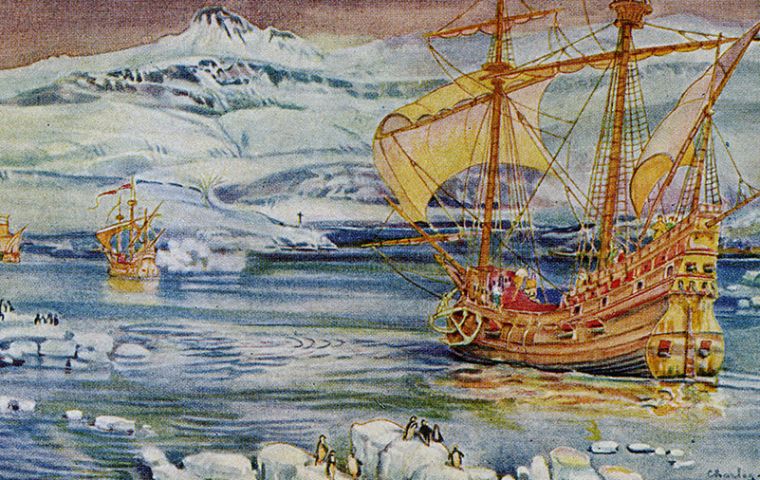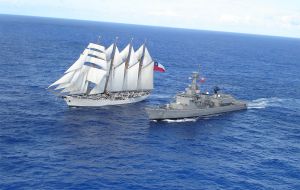MercoPress. South Atlantic News Agency
Chile and Spain celebrating the 500ths anniversary of the Magellan Strait discovery in Punta Arenas
 Ferdinand Magellan and Sebastian Elcano the first to circumnavigate the world. It took three years and they discovered the link between of the oceans
Ferdinand Magellan and Sebastian Elcano the first to circumnavigate the world. It took three years and they discovered the link between of the oceans  Chilean president Sebastian Piñera addressing naval units at Punta Arenas during the commemoration
Chilean president Sebastian Piñera addressing naval units at Punta Arenas during the commemoration  Tall ships Sebastian Elcano and Esmeralda, from Spain and Chile, sail along the Magellan Strait, next to a display of the modern Chilean navy
Tall ships Sebastian Elcano and Esmeralda, from Spain and Chile, sail along the Magellan Strait, next to a display of the modern Chilean navy Chile and Spain are celebrating the 500th-anniversary discovery of the Magellan Strait, on November first 1520, by the round of the world expedition of Fernando Magellan and his second in command Sebastián Elcano, who had left Spain on September 1519, with five ships and some 247 crew, and only returned three years later with one vessel and 18 men.
The five vessels expedition called in Cabo Verde island, the bay of Rio do Janeiro, the River Plate and San Julián in Patagonia, where they decided to land and spend the challenging austral winter, before heading for their destination of the Moluccas in search of spices. The trip to the Moluccas had been first completed by the Portuguese mariner Vasco do Gama but heading east, round South Africa, while Magellan was convinced there could be a similar crossway sailing to the west, which after much frustrations but Iberian determination it was finally confirmed.
In effect on October 21st 1520 one of his scout vessels, Santiago, discovered what seemed the east end of the link between the Atlantic and what was to be named the Pacific. Magellan on November first, after the austral winter confirmed the discovery and in accordance with the religious calendar named it the Strait of All Saints. Finally after several mutinies and the loss of two vessels Magellan and three remaining sailed across the 570 kilometers to the ocean which he expected would lead them, in a few days, to the Moluccas. But it took more than three months and Magellan was to die in one of the Philippines during a battle with the indigenous people for supplies.
From then on the expedition was in command of the Spanish mariner Sebstian Elcano, who finalized the circumnavigation, arriving back with one vessel, Victoria, and a crew of eighteen, completing the 70,000 kilometers, three years trip. In honor to their original captain, the strait was renamed Magellan Strait.
However despite the significance for world trade, communications and navigation, for over 400 years as the link between the two oceans, the pandemic impeded a great celebration planned for the half millennium anniversary in Punta Arenas.
There was a visit of president Sebastián Piñera for the inauguration of a monument to the anniversary, a great display and parade of the Chilean navy and the presence of the Spanish navy training tall ship Sebastián Elcano, with top brass from Spain. The Sebastian Elcano was built in Cadiz as the Chilean navy tall ship Esmeralda, where much of naval ceremonies took place.
A mass was celebrated at Bahía Fortescue, along the Magellan Strait, at the same place where on 11 November 1520 Fry Pedro Valderrama, chaplain of Magellan expedition, held the first mass ever in Chile and maybe the first Europeans to land in what is now Chile. A joint Spanish/Chilean naval display followed along the mythical Cape Horn saluting the Horn island lighthouse monument, which guides sailors and vessels at the lowest tip of the South American continent. This was followed by a visit to Port William along the Beagle Channel.




Top Comments
Disclaimer & comment rules-

-

Read all comments1520? Perhaps, but this globe was made in 1515
Oct 29th, 2020 - 05:16 am +1https://falklandstimeline.files.wordpress.com/2019/01/1515-johannes-sch%C3%B6ner-globe.jpg
Brasil should claim Antarctica on the basis of that map. :)
Oct 31st, 2020 - 11:24 am 0Commenting for this story is now closed.
If you have a Facebook account, become a fan and comment on our Facebook Page!